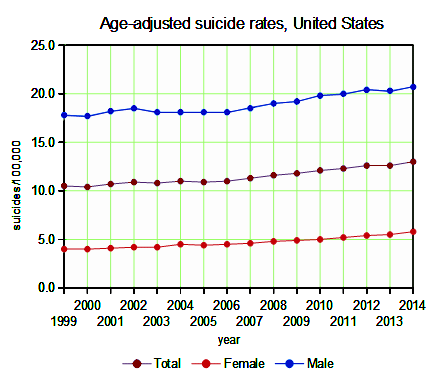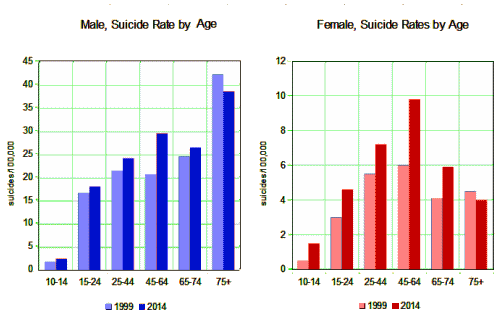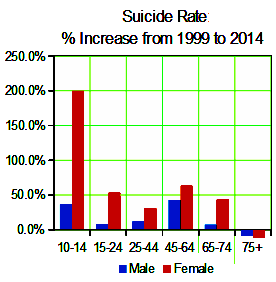New York TimesBy SABRINA TAVERISEAPRIL 22, 2016Suicide in the United States has surged to the highest levels in nearly 30 years, a federal data analysis has found, with increases in every age group except older adults. The rise was particularly steep for women. It was also substantial among middle-aged Americans, sending a signal of deep anguish from a group whose suicide rates had been stable or falling since the 1950s.
The suicide rate for middle-aged women, ages 45 to 64, jumped by 63 percent over the period of the study, while it rose by 43 percent for men in that age range, the sharpest increase for males of any age. The overall suicide rate rose by 24 percent from 1999 to 2014, according to the National Center for Health Statistics, which released the study on Friday.
The increases were so widespread that they lifted the nation’s suicide rate to 13 per 100,000 people, the highest since 1986. The rate rose by 2 percent a year starting in 2006, double the annual rise in the earlier period of the study. In all, 42,773 people died from suicide in 2014, compared with 29,199 in 1999…
But you know what? A lot of those are psychosocial explanations [throwing in MDD was facetious anyway]. I’m not a bit surprised that the suicide rate has crept up in almost every domain during that time period. I’d say that it’s because it represents an era when we’ve turned our backs on the patients we’re charged to take care of. If a patient shows up in a psychiatris’ts office suicidal – they’re going to get medications. If a patient shows up in a psychologist’s or social worker’s office suicidal – they’re going to be referred for medications. If they go to or are taken to an ER, they’re going to get medication. And my point is not anti-medication here. They may indeed need medication. It’s that medication is all they’re going to get. The same is true if they get admitted somewhere. It will be to a stabilization unit which they’ll leave in several days on medications [a lot of medications] and that will be that.



Another consequence of expansive labeling and attempting to treat three hundred pseudo-disorders and not doing a very good job instead of focusing on the 15-20 “heart attacks” organized psychiatry should be focused on.
Not to mention useless research like this:
http://fap.sagepub.com/content/20/3/365.abstract
Also, I think it goes without saying that this rise has paralleled the destruction of the family and the prolongation of adolescence. You didn’t have this in the thirties when economics were demonstrably worse by every objective standard.
With an extended family you had a backstop if two parents were impaired. With the nuclear family you might be lucky if one parent had it together if the other didn’t. With a single parent, the only backstop to a poorly functioning parent is a tired grandparent or the government, which doesn’t do a good job.
We’ve forgotten so much in the era of biopsychiatry, haven’t we. As a society, it appears we now know less than we did in 1897 with Durkheim’s publication of Suicide.
And now the fall out from the demographic at hand: middle aged women being the largest growing group abusing controlled substances, usually in multiple forms simultaneously. Frankly, and this will annoy some readers, it is time to see what culpability is at hand with these reckless and clueless PCPs and other non psychiatrist providers writing for benzos and stimulants like PEZ and then trying to dump their Frankenstein creations on psychiatrists.
Again, WHEN physicians hear and see their colleagues being successfully sued and “retired” from practice, maybe then we will see real change for the better? Oh that hot stove analogy, when will it sink in?…
Here’s a sad and sick prediction: once Trump and Clinton are announced as their party’s candidates, if there can’t be a third party/independent candidate who can step forward and be a realistic alternative, watch that suicide rate go up again in the space of months.
I am not advising or condoning this, just noting a painful truth, people aren’t able to problem solve anymore, their “smart”phones have just dumbed them down instead. And we have two people who are taking full advantage of this.
Personality disordered society, folks, we are hip deep in it!
I think what is so confusing now is that actually, some places really *are* offering exactly the kind of talk therapy– or one kind of talk therapy, anyway– that might help turn these numbers around, and at reasonable cost, too.
How a patient in need would ever find it, I have no idea. It would have to be word of mouth referral or blind luck.
Our outfit gets referrals from a huge insurance company. Maybe they’re even an HMO, I couldn’t say, I don’t want to identify them, I’m too scared something will frighten them away from this experiment.
They refer patients to us– and one of the ‘populations’, if you want to call it that, that they send us is patients who have moderate suicidal ideation.
It’s a crazy kind of therapy, in a way, because we have to say, “Well, you’re going to get at least 10 or 13 sessions, probably 20, possibly 30 or even 40.” So I wind up doing this hybrid CBT thing where I have DMH style measurable outcomes on my treatment plan, but I keep poking away at psychodynamic goals in case we have time for them. Sometimes, we do. But if they drop out at 5 sessions, at least i’ve given them some basic tools. If we get the rug pulled out from us at 10, 20, 30, or 40, we can actually review what we’ve done, and consolidate it in a way that they can pick up where they left off, either with someone else later or with me– in the same practice or another, a few years down the road. A lot of paperwork and not a lot of money, but I’ll be fine with this for at least a few years. Maybe longer. I believe in what this outfit is doing, and I really want them to be successful.
There are also outfits like the clinic where I did my internship for folks with fewer resources– but you have to be able to navigate their system and fit in the right demographic pigeonhole to get 20 or 30 sessions. Harder to see the same people year after year, but easier to come back for your second or third or fourth tour.
<>
Dr. O’Brien, I don’t want to go off on a tangent, but where I live and work, this seems like a wild and insupportable statement. There are communities of people living in tents in neighborhoods that have never had a serious problem with homelessness before. The cost of housing has skyrocketed, and wages are plummeting.
I think young people today live at home because they are terrified of what the economy and environment is going to be like in ten or 20 years, and they have every reason to be afraid– though it’s a dirty secret we’re not allowed to talk about, and the presenting issue will always be something else. They’re not like my generation; they’ve been intimidated into keeping their mouths shut, except for certain hot-button issues where they are allowed to complain, certain pathologies they are allowed to present with.
I absolutely think drugs prolong adolescence — both recreational and prescribed — but I think there’s a lot of unspoken fear, too. Particularly in places like this, where the beaches are littered with the carcasses of sick and dying animals, and the weather breaks records every year.
Mea culpa– the quote of Dr. O’Brien’s that got cut from my post was “in the thirties when economics were demonstrably worse by every objective standard.” I did not read this line carefully enough; what you say is objectively true. (I missed ‘in the thirties.’) My bad.
I do think we are getting close to a depression era economy. There is a soup kitchen, with a bread line, at the church down the street… the line just does not go around the block yet, but it is out the door and down the steps.
In 1937 I think we hit 24% unemployment by traditional metrics. Though we are allegedly at 5% unemployment now, by U6 standards we have very high unemployment because of the striking drop in labor force participation particularly by boomers with physical issues, obviously residing in a high suicide demographic.
What’s striking is that most of the 24 percent were trying to work and had not given up hope. Today the people caught between the official U1 and U6 numbers basically have given up hope of returning to work.
Hopelessness is obviously more correlated to suicide than a demographic high unemployment rate, since it is after all a symptom of depression. So in a sense we agree if we define our terms correctly.
Work does three things as a suicide buffer: it keeps the mind from wondering to idle dark thoughts and more importantly it defines a sense of purpose. It also imposes a forced community upon people who are avoidant or schizoid and need it for their own good but won’t voluntary seek friends.
What I’m saying is that I do agree with you on this socioeconomic factor depending how terms are defined. Yes, I think the “bowling alone” phenomenon is relevant.
Epidemiological studies need a lot of dissection before jumping to conclusions.I just read a number of explanatory hypotheses which may or may not be correct. The least, although far from sufficient,back up was some evidence that the actual data is along the lines that would follow from the hypothesis. One should also realize that suicide remains a quite rare event . Such events are extraordinarily sensitive to reporting biases. For instance it is often stated (I think correctly but is just opinion) that suicide used to be held to be a shameful blot on the family–the admission of such an event ruined the chance of any offspring getting married.
Nowadays a more naturalistic social approach makes the admission of suicide easier thus yielding a fallacious apparent increase. Maybe, but like any other hypothesis. could be investigated. It’s likely one could identify and document certain social or religious groups that consider suicide more or less shameful and see if the reported suicide rate covaries, One could even make an assumption loaded estimate if this was strongly correlative with the general finding.None of this is definitive but certainly can raise doubts or incite investigation. Say I suggested the increase in suicide was due to the decrease in smoking tobacco. Before getting into an argument ,would like to know several relevant comparative facts.
Cordially
Don Klein
“One should also realize that suicide remains a quite rare event .”
Rare per what criteria? Almost as rare as getting hit by lightening? Or shark attack? If in America there were only a suicide an hour in a 24 hour period each day, that would be about 10,000 a year, but, does that number look “rare” to other readers?
And how many suicides get lost as not defined as such a cause of death? Let’s be conservative and say only 20% of unclear deaths are missed as suicides, what if that number adds 20% to the documented figures of late?
probably an echo from the post, but here in a CNN article:
http://www.cnn.com/2016/04/22/health/suicide-rates-rise/
“Middle-aged women, between 45 and 64, had the highest suicide rate among women in both 1999 and 2014. This age group also had the largest increase in suicide rate: 63%, from 6 to 9.8 per 100,000. The 45-64 age group also had the largest increase in suicide rate among men: 43%, from 20.8 to 29.7 per 100,000. ”
I don’t see an 63% increase in just one demographic alone as rare, sorry. if it was truly about less than 100 people in a year’s time, fine, but that is not the number here. And, let’s all have a moment of brutal candor, the economy is NOT fine, if you work in CMHC’s, we are not seeing less people access them, but more, and, people 10 years ago who would not be coming to CMHCs because of economic status alone are now patients.
So, from someone at the front line, who has been doing CMHC work much of my 23 year career, seeing an increase in suicides is a serious, painful stat to read. And, I don’t have a drug that will get people jobs, get them out of bankruptcy, make their interpersonal relationships stronger, and certainly drugs do NOT substitute for psychosocial interventions like therapy and other ancillary services like case management and social work services now completely taxed out of healthy intervention ability.
Oh, and seeing these middle aged women coming in on opiates, benzos, and stimulants SIMULTANEOUSLY only adds to suicide risk factors. Sooo, maybe one of the points to this media coverage isn’t just about numbers, but, an indictment about the level of caring, or more accurately the lack of caring going on in communities across the country???
Which to me, sorry to make it political Dr N, is I believe the unspoken mantra of the Democrat Party, who has lost the white vote, and thus passing legislation and other bureaucrautic intrusions to limit white American supports and benefits. Call me a conspiracy nutcase, deeds speak louder than words, and the Democrats seem to support political causes that diminish the support to white Americans. As less of them as voters seem to make Democrat voting blocks more powerful by keeping Democrat hacks in power???
Cue “Batman Begins”, when Ra’s al Ghul educates Bruce Wayne that the criminal is not complicated, and at the end of the day, I don’t see the agenda of entrenched antisocial politicians as complicated: if people who don’t support the incumbent aren’t around or alive, then the politician stays in office.
Am I wrong? And is part of the suicide demographic an illustration of a corrupt political system using it for nefarious gain?! You review and decide…
Great point, Doctor O’Brien, about what we might call occupational hopelessness. Major presenting issue in a substantial percentage of my humble caseload, and most of these clients also have some flavor of SI.
Also, thanks for the link to the abstract of the article on trans-species psychology. I haven’t yet shelled out the $38 to access the full .PDF, but i am sure it is a towering masterwork, a beacon of hope for those of us who are seeking to restore the reputation of Qualitative Research. Though curiously, after reading the abstract, I did scale higher on the Existential Subtest of the Occupational Hopelessness Index.
Not to fly off onto a tangent, but one of my jobs is at a local university where my consulting room has an extensive library of books about the Pacific theater in WWII, and at lunch I have been studying the daily lives of kamikaze pilots stationed at Mabalcat.
I am glad I was not a Japanese pilot in the Phillippines in 1943. You could say that those guys were pretty hopeless before they started flying the missions; from what I can see so far, in many ways they were pretty cheerful once they had a plan and started executing it.
Chilling.
I used “rare” as a qualitative adjective describing the frequency of suicide . Joel Hassman wishes me to define “rare” in this context. His estimates seem based on personal experience and depth of feeling. The suicide rate is approximately 13 per 100,000. It is very likely that this is an underestimate due to under-reporting .So let’s work with 25 per 100,000. In decimal form that is 0.00025 which impresses me as rare. Statistically an inferential index can be treated as expectable or rare in terms of it’s generating process. A proportion equal to 0.05 or less is often taken to indicate rare. Another analogy derives from useful tests ,rare base rates and prediction. If there were a disease ,occurring at the suicide rate, with the an excellent diagnostic test ( sensitivity and specificity both equal to 0.9) what proportion of those with positive tests actually have the disease(PPV) ? About 2 per thousand. Very disappointing. Further, since the PPV is a direct function of base rate ,if the disease rate was 10 times larger, the PPV increases to 2 per hundred or conversely the test is still wrong 98 times out of one hundred. Maybe, some feel the tests should be better. If we estimate both sensitivity and specificity at 0.99 and use 10 times the suicide rate, we have achieved 20 correct calls per hundred. That seems convincing (to me) that the suicide rate can be appropriately considered “rare”.
Among males , since 2000 ,whites have consistently the highest rates (Increasing from about 11 to about 14/100000), next are American Indians ( increasing slightly, about 10 to 10.3/100000), while a distant third were Asian/Pacific Islanders, Hispanics and Blacks, that run consistently about 5.1/100000 .( Read off an American Foundation for Suicide Prevention graph). The psychosocial variables proffered to explain such dispersions fall quite short of the job and are probably even more ineffective for lesser differences.Referring to epidemics seems baseless fear mongering.
Are there relevant statistics for the reported opioid epidemic? Percentage increments are insufficient. Please refer me to useful data.